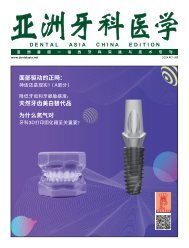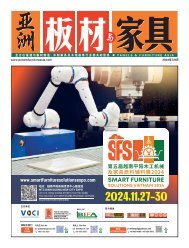Water & Wastewater Asia January/February 2021
Water & Wastewater Asia is an expert source of industry information, cementing its position as an indispensable tool for trade professionals in the water and wastewater industry. As the most reliable publication in the region, industry experts turn this premium journal for credible journalism and exclusive insight provided by fellow industry professionals. Water & Wastewater Asia incorporates the official newsletter of the Singapore Water Association (SWA).
Water & Wastewater Asia is an expert source of industry information, cementing its position as an indispensable tool for trade professionals in the water and wastewater industry. As the most reliable publication in the region, industry experts turn this premium journal for credible journalism and exclusive insight provided by fellow industry professionals. Water & Wastewater Asia incorporates the official newsletter of the Singapore Water Association (SWA).
You also want an ePaper? Increase the reach of your titles
YUMPU automatically turns print PDFs into web optimized ePapers that Google loves.
FOCUS 31<br />
learning curve has shortened…<br />
Previously, you’d need a few months,<br />
maybe even years, depending on the<br />
person who is able to train them to<br />
use tools for leak detection.<br />
Smartphone sensors are used to monitor smaller water pipes<br />
and detect leaks within two metres of the pipe<br />
The trial was successful, with<br />
the sensors detecting 13 leaks<br />
over a three-year period. In one<br />
incident, the sensors alerted PUB<br />
to a potential leak on a 700mm<br />
diameter water pipe alongside a<br />
major expressway in 2018. Upon<br />
excavation, a 13mm corrosion hole<br />
was discovered at the bottom of the<br />
pipe, within 0.5m of the location<br />
reported by the sensors. This early<br />
detection allowed PUB to promptly<br />
repair the pipe and prevented further<br />
water loss. Following up from the<br />
trial, PUB plans to progressively<br />
scale up the number of sensors<br />
in the network and deploy 1,200<br />
sensors islandwide for leak<br />
monitoring by <strong>2021</strong>.<br />
PUB is also exploring use of inline<br />
pipe inspection tools for leak<br />
detection in large water mains. The<br />
tool is inserted directly into the pipe,<br />
which allows for more targeted and<br />
precise inspection of the pipe wall,<br />
to detect any cracks or anomalies.<br />
Propelled by the flow of water in the<br />
pipe, these tools can easily survey<br />
long stretches of a pipe in a single<br />
deployment. One such tool is a ballshaped<br />
sensor that can pinpoint the<br />
leak location to an accuracy of two<br />
metres by picking up acoustic or<br />
noise signature related to leaks.<br />
PUB will be deploying these sensors<br />
to survey 500km of pipes over the<br />
next five years.<br />
For smaller water pipes, the<br />
PUB leak detection teams were<br />
recently equipped with smartphone<br />
sensors, a portable and easy-touse<br />
survey tool that has proven<br />
to be effective in locating leaks.<br />
The sensor, connected to a<br />
smartphone, is placed on pipe<br />
fittings such as hydrants and valves<br />
to pick up sounds from the pipe.<br />
The smartphone automatically<br />
digitalises and analyses the<br />
acoustic signal in real-time via a<br />
dedicated mobile application to<br />
check for leaks. Two sensors can be<br />
deployed on separate pipe fittings<br />
at once to correlate and pinpoint<br />
the leak location within two metres<br />
along the pipe.<br />
JUST KEEP LEARNING<br />
This new technology has also made<br />
it easier for younger engineers to<br />
learn on the job. Waseem Khan,<br />
senior engineer with the <strong>Water</strong><br />
Supply (Network) Department,<br />
commented, “The training and<br />
When you’re using the listening<br />
stick, it’s actually very complicated<br />
because there are other ambient<br />
noises present – vehicular traffic,<br />
people using water, environmental<br />
noises that are present – and you<br />
have to do all that processing and<br />
filtering in your brain. That takes<br />
years and years of training, but if<br />
you’re using a smartphone sensor<br />
like we are right now, all that filtering<br />
and amplification is going on in the<br />
phone. All the user has to do is listen<br />
out for the leak noise.”<br />
That isn’t to say that older engineers<br />
like Ong Guan are left behind,<br />
however – the 66-year-old extolled<br />
the virtues of self-improvement<br />
and shared how his keenness to<br />
learn has brought him to places like<br />
Brunei and Mauritius to provide leak<br />
detection consultancy services.<br />
“In the many years I’ve spent doing<br />
leak detection management, I’ve<br />
been able to apply my previous<br />
experience… And with these<br />
new skills, I’m able to train new<br />
engineers,” he said.<br />
Photos by Natalie Chew<br />
With a willingness<br />
to keep learning,<br />
older engineers<br />
like Ong Guan<br />
are able to stay<br />
on top of new<br />
technology<br />
used for leak<br />
detection – and<br />
train younger<br />
engineers too!<br />
<strong>January</strong> / <strong>February</strong> <strong>2021</strong> • waterwastewaterasia.com


















